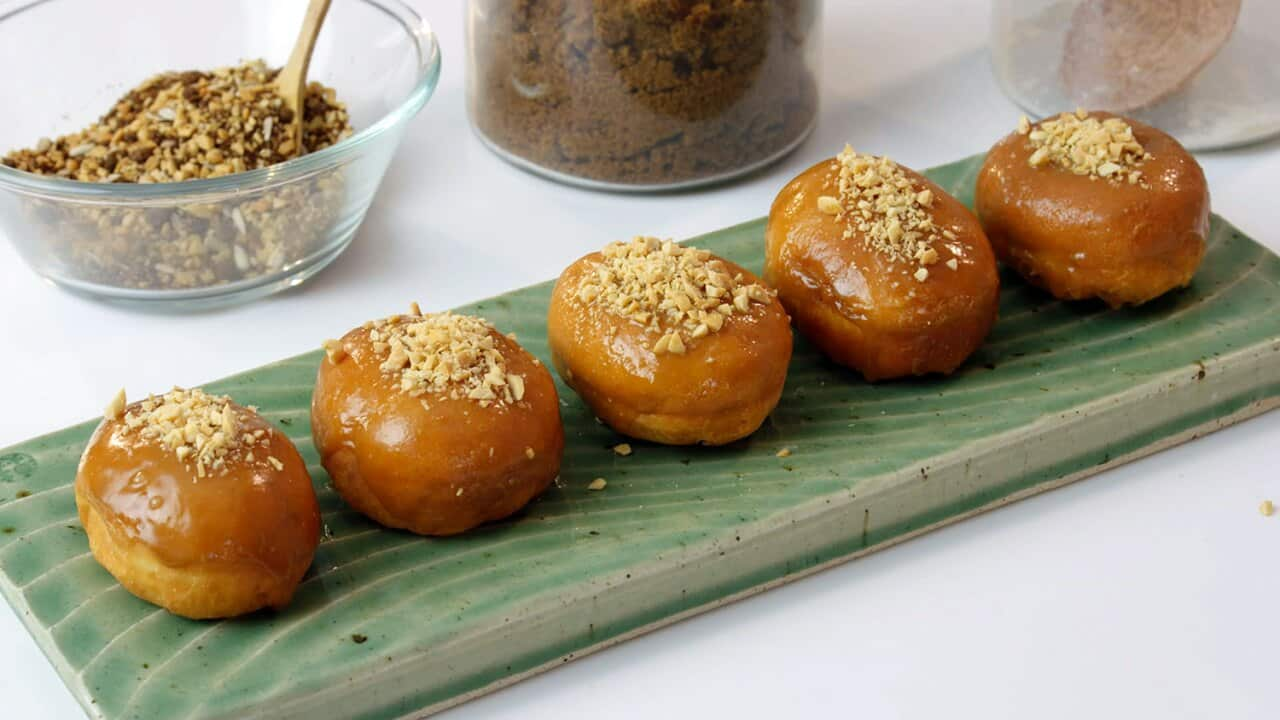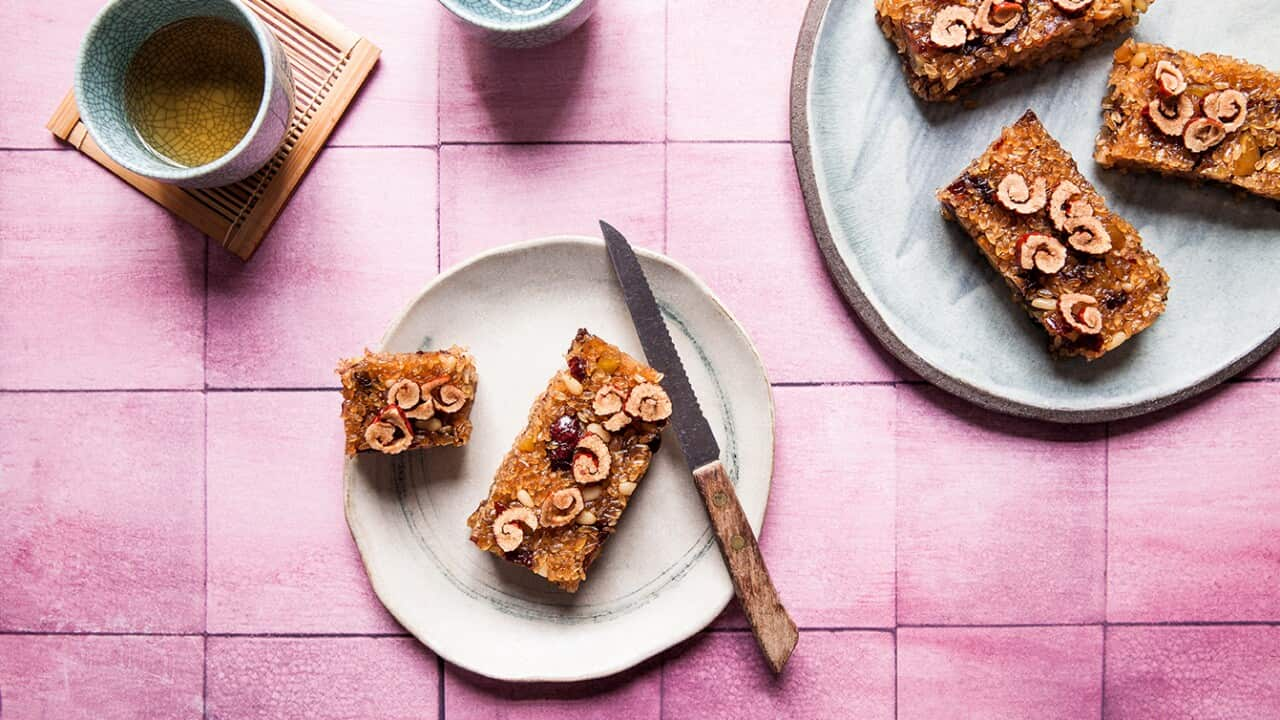“It’s absolutely delicious … probably my favourite street food,” says Heather Jeong. She’s talking about hotteok, a fried, filled pancake that’s popular across Korea, at street stalls and food halls.
The traditional version is sweet, a flattish disk, sometimes like a pancake, sometimes thicker, like a filled doughnut. A mix of sugar, cinnamon and, often, nuts or seeds, is the more traditional filling, creating a hot, gooey, sometimes slightly candied centre, tucked inside the crisp-edge pancake, although savoury versions have become popular too.
“It's all over Korea … you won't find it in every corner. But wherever you see it, it's quite, quite busy,” says Jeong, a cook and cooking teacher who not only makes them at home, but taught a class on hotteok at the in Sydney earlier this year.
“The most traditional filling is brown sugar, cinnamon and some sort of nuts, just a tiny bit of nuts – perhaps walnuts, or sunflower seeds… but the main ingredient is sugar and cinnamon.” The yeast-risen dough is a usually a mixture of plain flour, rice flour and milk or water, although like the filling – and the shape – there are many variations.
The yeast-risen dough is a usually a mixture of plain flour, rice flour and milk or water, although like the filling – and the shape – there are many variations.

Especially popular in winter, hotteok is often served folded, in a cup. Source: Getty Images / Jihyeok Han
“When I was growing up, it was always sweet, but now it's savory as well,” says Jeong, who moved to Australia with her parents when she was nine.
“There's hundreds of variations. There's japchae - usually sweet potato noodles with different vegetables, there's japchae with seafood, there’s seafood and chili … Another popular one is red bean filling. And kids love cheese in Korea, so another favourite is mozzarella cheese or any type of cheese. I've seen chocolate, too. I’ve made it at home with Nutella, or blocks of chocolate, and it’s really nice as well. And another popular one is where you add Korean tea powder to the dough.”
The Korean port city of Busan, she says, has popularised ssiat hotteok – seed hotteok. “Once they make the hotteok, they cut it open and then they put in a mixture of all these different nuts and seeds. It's delicious. Not my favourite hotteok, but it's very popular.”
Her favourite? The traditional sweet version, with that hot, sticky cinnamon-sugar filling.
“You could find 50 different variations, but in the most traditional, the dough is a mixture of flour and rice flour. The dough is left to prove, then you add the sugar and cinnamon filling and then, traditionally, you’d pan-fry it.”
Whether you’re making sweet or savoury, the technique is the same.
“You get a piece of dough, you flatten in. You've got to wet your hand with either oil or water so that the dough doesn't stick and then put some filling in the middle,” Jeong explains, “and then you make it a little parcel.”
The parcels are placed into a heated pan and – this is important, Jeong says – “you leave it alone until the bottom is sort of golden brown. And that's when you flip it, and squash it … Because if you think about it, if you squash it in the beginning, the sticky dough would stick to your spatula.” The finished hotteok develops a golden crust on both sides, encasing a rich, sugary filling. A rich, sugary, and potentially molten hot filling!
The finished hotteok develops a golden crust on both sides, encasing a rich, sugary filling. A rich, sugary, and potentially molten hot filling!

Heather's homemade hotteok: cook, then flip and flatten, she says. Source: Heather Jeong
“Because it's so hot, because it's straight off the grill or the oil, they usually fold it in half and then put it in a paper cup, so you don't burn yourself with the gooey syrup!” she says.
In South Korea, you might also find hotteok that are fried in oil, and this method, when used with thicker pancakes, creates something almost like a fried doughnut. Another version sees the hotteok cooked more like a waffle, in a flat-plated griddle machine – “it’s a healthier version, and it’s delicious as well,” says Jeong.
It’s this version that Donal Skehan is introduced to in Donal’s Asian Baking Adventure, when he visits Mangwon Market in Seoul with local chef Wonil Lee. “It’s my childhood favourite,” Lee says and Skehan soon sees why, as he cautiously bites into a folded hotteok.
“Oh my gosh … it’s super sweet and actually, as it’s cooling, what you’ve essentially created is a caramel and as it starts to kind of thicken, you get this little bit of a kind of a sugary crunch to it,” Skehan says.
The good news if that you don’t have to make the trek to South Korea to try this deliciously variable pancake-meets-doughnut.
At in Sydney, the dessert menu features a cinnamon doughnut served with thyme ice-cream and caramelised apples, glazed with cinnamon sugar – hotteok by another name. “We call it a Korean doughnut, because not everyone would know hotteok,” says co-owner Hyunchul Kim, “and we explain to customers that it’s a traditional Korean street food. It’s really popular – people come back just for that.”
“We call it a Korean doughnut, because not everyone would know hotteok,” says co-owner Hyunchul Kim, “and we explain to customers that it’s a traditional Korean street food. It’s really popular – people come back just for that.”

Soul Dining's version comes topped with apple Source: Soul Dining
Soul Dining’s version, made with plain flour and rice flour and filled with sugar like the traditional version, is pan-fried and then finished in the oven. “We finish it in the oven, so it gets cooked through, and the filling gets caramelised. The dough is chewy and pillowy, it has a good bite to it,” Kim says.
“It’s just flour, cinnamon, sugar and apple – but sometimes the simplest of sweets is the most popular.”
, a Korean restaurant in Melbourne, serves theirs with salted caramel sauce, vanilla ice-cream, nuts, berries and green tea powder.
“The way we serve it is different, but the hotteok is traditional,” manger Jenny Ho tells SBS Food. “It’s quite popular – it’s been on the menu from the start.” You can also very easily make your own – try from Jeong, filled with sugar, cinnamon and peanuts; , which includes walnuts and black sugar in the filling; or , served with ice-cream and black sesame seeds (below). Or try Donal Skehan’s , inspired by his eating adventures in Seoul.
You can also very easily make your own – try from Jeong, filled with sugar, cinnamon and peanuts; , which includes walnuts and black sugar in the filling; or , served with ice-cream and black sesame seeds (below). Or try Donal Skehan’s , inspired by his eating adventures in Seoul. There’s also a short cut that gets the tick of approval from Jeong.
There’s also a short cut that gets the tick of approval from Jeong.

Hotteok at Suda: served with berries, ice-cream and caramel sauce Source: Suda

Brown sugar and peanut-filled hotteok, delicious with ice-cream and black sesame seeds Source: Chris Chen / Feast Magazine
“The first thing I did when I used to go back to Korea was go and buy hotteok,” she says. “But about 10 years ago they started selling ready mixes in the supermarkets. As a chef and cooking teacher I would never usually buy ready mixes – but for hotteok, it’s brilliant, it’s absolutely brilliant.”
The packet mixes are available in Australia – look for them at Korean supermarkets.
Whichever way you buy, make or serve your hotteok, we’re fairly sure your verdict will be the same as Jeong’s: “It's absolutely delicious. I love it!”
Look out on the for details of more cooking classes by Heather (she's finished for this year, but will be starting again next year).








